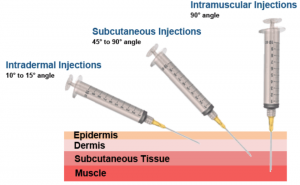31 SQ injections
Injections can be given via several routes its important to double check your labels and formulary-giving medications via the wrong route or wrong dose, and not recording is a common in malpractice law suites. ALWAYS look it up! Verify and double check, and record dose, route and location. Plumbs Veterinary Drugs is a good all around source-previous faculty member at U of MN, CVM!
- What are the contraindications for this medication?
- What are the indications for this medication?
- Can this medication be given by this route?
- Is there a different dose via this route?
- What is the volume limit to this route?
- Can this medication be given to this species?
- Is there a holding time for this drug in this species?
- Is this medication too viscus to be given by this route-can it be diluted? and what is it compatible with?
No worries, you’ll learn this information above over the course of your education, just know that you should always double check and verify, and record everything!
Typically single use vaccine labels have all the pertinent information and can be scanned, or pre-loaded into clinic software, and labels can be stuck into paper records. Always note location vaccine given on animal and date of vaccine. Occasionally there are recalls when animals may need to be re-vaccinated. Good record keeping can make this easy.
In general here are the recommended angles of needle insertion for Intradermal, Subcutaneous, and Intramuscular Injections, in the SA patient. The angle of the needle helps to inject in the proper location, as well as tenting the skin to obtain access to SQ.

Often in LA patients, due to multiple factors including close access to patient who is in head gate etc…instead of angling the needle, we choose the appropriate length of needle to inject into the proper area, often using a multi-dose injector gun. There are charts available to determine which needle to use and drug labels and protocols often indicate needle size and location of injection. These locations are important especially for meat animals, as injecting into a prime cut of meat would be an issue! Also withholding times for many drugs exist, the LA vet needs to be well aware of these to prevent milk from needing to be discarded, or an animal shipped for slaughter within these times.
SQ INJECTIONS IN A NUTSHELL
- Always read the label and verify drug, concentration and dose and SQ route
- SA tent the skin over injection site insert needle about 45 degree angle, draw back and inject using “OK” method. Verify location of injection in animal
- Cats vaccines typically close to elbow/stifle (Feline vaccine associated sarcoma)
- Most clinics have vaccine protocol for sites of given vaccines. Example-Lyme in left rear, Lepto in left front. Y further back in alphabet than E, both start with L.
- LA choose appropriate needle size and length verify with chart and protocol.
- Record drug, dose, route and location of injection.
Insert video of SQ injection here
